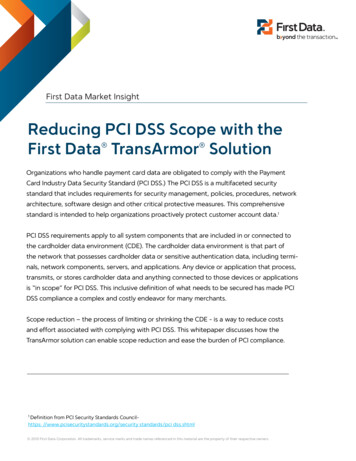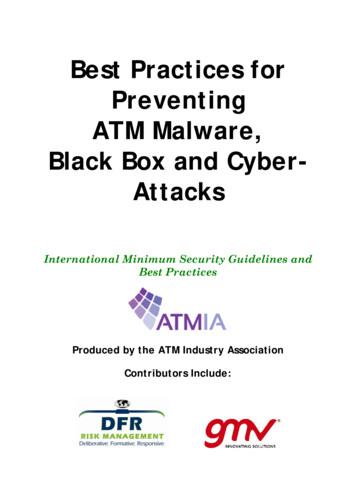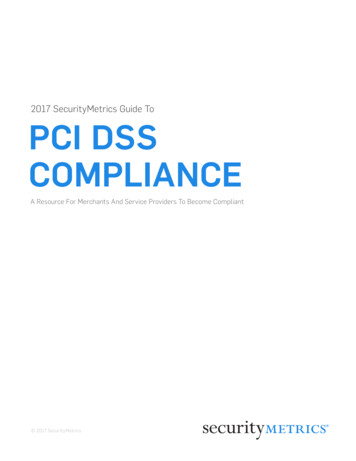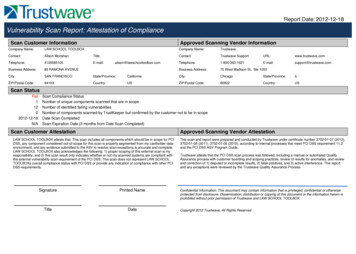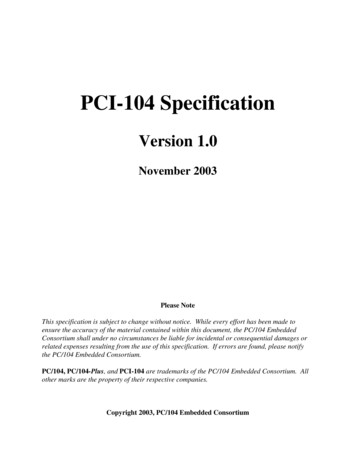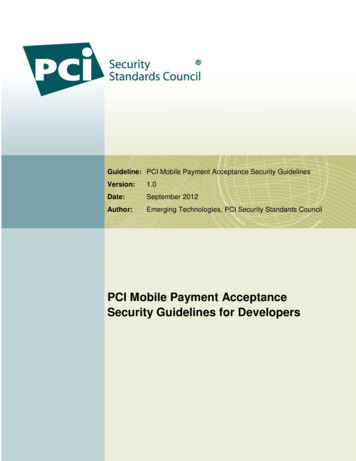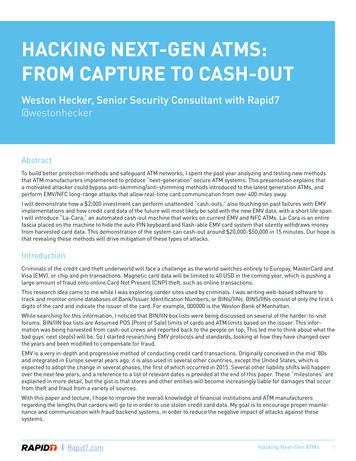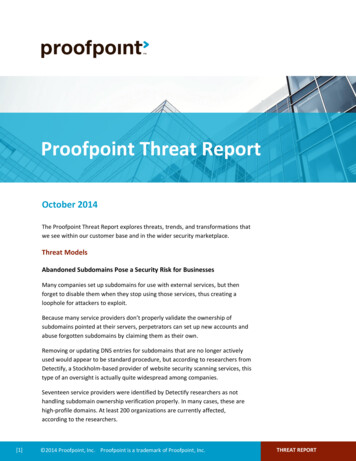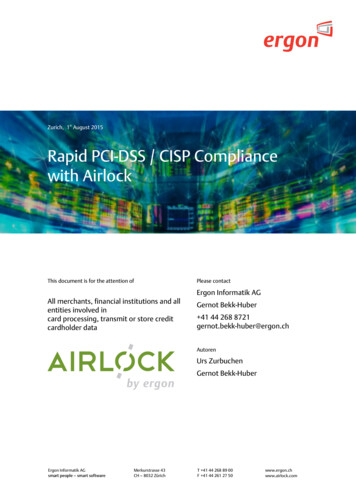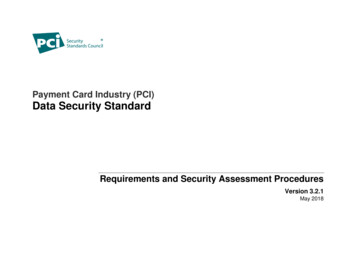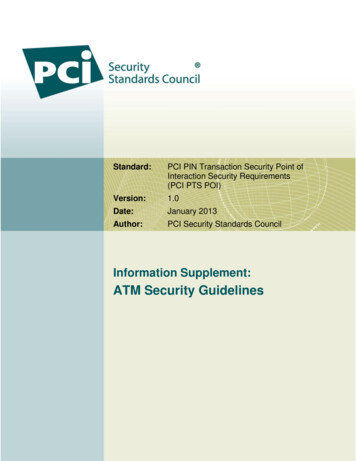
Transcription
Standard:PCI PIN Transaction Security Point ofInteraction Security Requirements(PCI PTS POI)Version:1.0Date:January 2013Author:PCI Security Standards CouncilInformation Supplement:ATM Security Guidelines
Information Supplement PCI PTS ATM Security Guidelines January 2013The intent of this document is to provide supplemental information. Information provided here does not replaceor supersede requirements in any PCI SSC Standard.i
Information Supplement PCI PTS ATM Security Guidelines January 2013Table of Contents1Related Publications . 22Introduction . 42.12.22.32.42.53Introduction to ATM Security . 83.13.23.34Background Information . 8ATM Security Overview . 8ATM Technical Standards . 10ATM Guidelines . 114.14.24.34.45Document Purpose and Scope . 4Intended Audience . 4Terms and Acronyms . 4Objectives . 6Content Organization . 7Integration of Hardware Components . 11Security of Basic Software . 18Device Management/Operation . 23ATM Application Management . 29About the PCI Security Standards Council . 31Annex 1:ATM Reference Model . 32Annex 2:Criteria for the Privacy Screen Design . 34Annex 3:Attack Potential Formula (Adopted from JIL) . 37The intent of this document is to provide supplemental information. Information provided here does not replaceor supersede requirements in any PCI SSC Standard.1
Information Supplement PCI PTS ATM Security Guidelines January 20131 Related PublicationsThe following ATMIA/GASA, European Payment Council, Microsoft, Trusted Security Solutions,NIST, and PCI standards are applicable and related to the information in this document.StandardSourceANSI X9.24: Retail Financial Services Symmetric Key ManagementANSIATMIA/GASA, Best Practice for ATM Transaction SecurityATMIA/GASAATMIA/GASA Best Practices for ATM Cyber SecurityATMIA/GASAATMIA/GASA Best Practices PIN Security & Key ManagementATMIA/GASArecommendationATMIA/GASA, ATM lifecycle Security Manual, International minimumATMIA/GASAsecurity guidelinesATMIA, ATM Software Security Best Practices GuideATMIAGuidelines for ATM SecurityEuropean PaymentCouncil DTR 413Recommended ATM anti-skimming solutions within SEPAEuropean PaymentCouncil Doc115-8ISO 11568: Banking – Key Management (Retail)ISOMicrosoft Windows XP-based ATM Security Design A solution for secure,Microsoftwell-managed ATMs using Windows XP and Active DirectoryMicrosoft Managing Windows XP-based ATMs Using SMS and MOM AMicrosoftsolution for secure, well-managed ATMs using Windows XP, ActiveDirectory, Systems Management Server, and Operations ManagerMicrosoft Windows XP-based ATM Security DesignMicrosoftMicrosoft Active Directory Design for Windows XP-based ATMs A solutionMicrosoftfor secure, well-managed ATMs using Windows XP and Active Directory2009 Update: Remote Key LoadingTrusted SecuritySolutionsGuidance for securing Microsoft Windows XP systems for IT ProfessionalsNISTWireless Management and Security — Part 1: General RequirementsNISTWireless Management and Security — Part 2: ATM and POSNISTPayment Card Industry Data Security Standard Requirements andPCI SSCSecurity Assessment ProceduresPayment Card Industry Payment Application Data Security StandardPCI SSCThe intent of this document is to provide supplemental information. Information provided here does not replaceor supersede requirements in any PCI SSC Standard.2
Information Supplement PCI PTS ATM Security Guidelines January 2013StandardSourceRequirements and Security Assessment ProceduresPayment Card Industry PTS POI Modular Security RequirementsPCI SSCPayment Card Industry PTS POI Derived Test RequirementsPCI SSCPayment Card Industry PIN Security RequirementsPCI SSCNote: These documents are routinely updated and reaffirmed. The current versionsshould be referenced when using these requirements.The intent of this document is to provide supplemental information. Information provided here does not replaceor supersede requirements in any PCI SSC Standard.3
Information Supplement PCI PTS ATM Security Guidelines January 20132 Introduction2.1 Document Purpose and ScopeThis document proposes guidelines to mitigate the effect of attacks to ATM aimed at stealing PINand account data. These guidelines are neither definitive nor exhaustive and are not intended tobe used as requirements for a validation program at the PCI SSC.For additional information regarding any compliance questions, contact the payment brand(s) ofinterest.2.2 Intended AudienceThis Information Supplement is intended for ATM manufacturers, integrators, and deployers ofATMs.2.3 Terms and AcronymsTerm/AcronymDescriptionACATM controllerATM compromiseA violation of the security of a system such that an unauthorizeddisclosure of sensitive information may have occurred. This includes theunauthorized disclosure, modification, substitution, or use of sensitivedata (including plaintext cryptographic keys and other keying material).ATM FraudThe illegal procurement of cash, money value or cardholder informationvia ATM networksEPPEncrypting PIN PAD, a tamper-responsive security device that providessecure PIN entry and storage of cryptographic material. It is designed tobe integrated into ATMs or self-service POS terminals.FasciaATM front, available for user cardholder interaction: It normally includesthe devices required for cardholder interface, such as the (secure)keypad, the card-reader slot or the NFC-device reader, the screen etc. Itmay also include the note-dispensing tray; the deposit-takingcompartment, etc.NFCNear Field CommunicationStandards that enable payment applications to communicate withterminals by being in close proximity with a reading pad in the terminal.The intent of this document is to provide supplemental information. Information provided here does not replaceor supersede requirements in any PCI SSC Standard.4
Information Supplement PCI PTS ATM Security Guidelines January 2013Term/AcronymDescriptionPCI DSSPCI SSC Data Security StandardThe PCI DSS is a multifaceted security standard that includesrequirements for security management, policies, procedures, networkarchitecture, software design, and other critical protective measures. Thiscomprehensive standard is intended to help organizations proactivelyprotect customer account data.PCI PA-DSSPCI SSC Payment Application Data Security StandardThis document is to be used by Payment Application-Qualified SecurityAssessors (PA-QSAs) conducting payment application reviews; so thatsoftware vendors can validate that a payment application complies withthe PCI DSS Payment Application Data Security Standard (PA-DSS).This document is also to be used by PA-QSAs as a template to createthe Report on Validation.PCI PTSPCI PIN Transaction Security StandardThis standard includes security requirements for vendors (PTS POIRequirements), device-validation requirements for laboratories (DerivedTest Requirements), and a device approval framework that produces alist of approved PTS POI devices (against the PCI PTS POI SecurityRequirements) that can be referred to by brands’ mandates.The PCI PTS list is broken down into the following Approval Classes ofdevices: PIN Entry Devices (PEDs—standalone terminals), EPPs(generally to be integrated into ATMs and self-service POS devices),Unattended Payment Terminals (UPT), Secure Card Readers (SCRs),and Non-PIN-enabled (Non-PED) POS Terminals.PCI SSCThe Payment Card Industry Security Standards Council, the organizationset up by international payment brands to provide global securityrequirements applicable to electronic card payment systems.The role of PCI SSC also includes the setting up of standards for thevalidation of merchants, service providers, and devices against therequirements agreed by brands in PCI SSC.The brands may use approvals issued by PCI SSC in their mandates’requirements.Sensitive dataPIN, account data, secret keys, and other sensitive keying material that agiven device relies on to protect characteristics governed by PCI PTSPOI Security Requirements, PCI DSS, and PCI PA-DSS.The intent of this document is to provide supplemental information. Information provided here does not replaceor supersede requirements in any PCI SSC Standard.5
Information Supplement PCI PTS ATM Security Guidelines January 20132.4 ObjectivesThis document identifies security guidelines for ATMs, considering the protection that can beprovided by the hardware and the software of the ATM itself against attacks aimed atcompromising sensitive data acquired, stored, exported, or in any way processed by the device.The primary focus is the mitigation of magnetic-stripe or equivalent image data-skimming andPIN-stealing attacks at ATMs or other ATM manipulation to steal cardholder information, whichare most prevalent during the ongoing transition of payment systems to chip technology.This document is aligned with the security approach and modularity of the PCI PTS POI set ofsecurity requirements and is intended to provide: Security guidance to acquirers and ATM operators that purchase, deploy, and/or operateATMs. Security guidance and best practices to the ATM industry stakeholders, which includesATM acquirers, manufacturers, software developers, security providers, refurbishers, et al.The security guidelines in this document build upon a series of existing standards (IT, security,payment card, and ATM industry). As compromise-prevention best practices, they are NOTintended to: Provide a set of security requirements for the formal security certification of ATMs. Be used as fraud-prevention guidelines (transaction monitoring, card-authenticationprocedures, etc.) Identify guidelines preventing the physical access to the cash stored in the ATM or to thesite where the ATM is deployed. Identify guidelines for the placement of ATMs.The intent of this document is to provide supplemental information. Information provided here does not replaceor supersede requirements in any PCI SSC Standard.6
Information Supplement PCI PTS ATM Security Guidelines January 20132.5 Content OrganizationChapter or AnnexChapter 3 – Introduction toATM SecurityChapter 4 – ATM GuidelinesA – Integration ofhardware componentsContent ATM Services Overview ATM Security Overview ATM Technical StandardsSecurity Targets EPP, readers, cabinet,anti-skimming devicesIntended AudienceATM manufacturers, repairingorganizations, refurbishers Guidelines for furtherintegrators and softwaredevelopersB – Security of basicsoftware OSC – Device management/operation Cryptographic/keymanagement, frominitialization/distribution todecommissioning Middleware (XFS,multivendor software,Open Protocols)Software integrators,application developers, ATMmanufacturersATM deployers/operators andsupportingorganizations/serviceproviders ATM individual securityconfiguration (HW andsoftware) Environment securityD – ApplicationmanagementSecurity functions driven bythe ATM application andapplication managementApplication developers,software integrators, ATMoperatorsAnnex 1: ATM ReferenceModelA diagram with a generic ATM architecture, its components,and basic interactionsAnnex 2: Criteria for thePrivacy ScreenDesignAn introduction to privacy screen designAnnex 3: Attack PotentialFormulaAn introduction to attack potential calculation ATM individualsecurity configuration (hardware and software)(Adopted from JIL)The intent of this document is to provide supplemental information. Information provided here does not replaceor supersede requirements in any PCI SSC Standard.7
Information Supplement PCI PTS ATM Security Guidelines January 20133 Introduction to ATM Security3.1 Background InformationSince the introduction of ATMs in the late sixties in the UK, these card-acceptance devices havebeen playing a key role both in the bank-services-automation arena and in the 24/7 cash supplyto the economy in general as well as to commerce.ATMs deliver service in a wide range of environments, from bank branches and conveniencestores to unattended locations at shopping malls and business centers.The number of ATMs worldwide reached 2.25 million units by the end of 2010. This numberrepresents growth of 7.3% in one year. Around 100,000 new units were deployed in Asia-Pacific1markets alone .Whereas ATMs are primarily engineered to securely store/dispense bank notes and takedeposits, they are the preferred self-service platform for an increasing number of servicesavailable to cardholders. These include payment of utility bills, topping up of mobile phones,reloading prepaid cards, etc. Other services such as payment of government benefits,entitlements, or micro loans require the disbursement of cash.As cards and the acceptance infrastructure migrate to chip and NFC technologies, ATMs willcontinue to play a key role in providing increasingly complex services to chip cards and NFCenabled device holders.3.2 ATM Security OverviewThe cash in transit or stored in the ATM safe has been the asset traditionally targeted by ATMcriminals, sometimes in rather violent ways. However, in the last years, attackers have turnedtheir attention equally to soft assets present in the ATM, such as PINs and account data.Criminals use this stolen information to produce counterfeit cards to be used for fraudulenttransactions—increasingly around the world—encompassing ATM withdrawals, purchases withPIN at the point of sale, and purchases without PIN in card-not-present environments.PINs and account data are assets belonging to cardholders and issuers. They are inevitably in“clear” form at the ATM, when the card and PIN are entered. By attaching, for example, a pinholecamera and a skimmer to the ATM, a criminal can steal PINs and account data before they canbe securely processed by the ATM.These attacks require a relative low attack potential, in terms of both skills and material that iscommercially available. The latest generations of skimmers and cameras are unnoticeable tountrained eyes and can be quickly installed and removed from the ATM without leaving any trace.In high traffic ATMs, dozens of PINs and associated account data sets can be stolen in a fewhours.1RBR London, “Global ATM Market and Forecasts to 2016”The intent of this document is to provide supplemental information. Information provided here does not replaceor supersede requirements in any PCI SSC Standard.8
Information Supplement PCI PTS ATM Security Guidelines January 2013The first line of defense to these attacks has to be offered by the ATM itself. Countermeasures atdevice level include detection of attached alien objects, disturbance of magnetic-stripe readingnear the entry slot, etc. Alarms generated by the device should be acted upon promptly andcomplemented with inspections of the ATM, more frequently at higher-risk installations.More sophisticated attacks can involve criminals’ locally accessing resources of the PC—USBports, for example—to install malware and harvest stolen data. These attacks can be combinedwith or replace remote attacks that exploit vulnerabilities related to the exposure to opennetworks.Attackers take advantage of the inherent design and integration of the ATM as a self-service,card-accepting device. The most significant aspects of an ATM’s architecture and usage thatdraw the attention of criminals are as follows:1. ATM transactions generally require PIN entry and the reading of the card’s magnetic stripeand/or the EMV chip. Attackers have therefore the opportunity to capture pairs of PIN andaccount data that are highly valued in the underground compromised-account-data market.2. ATMs are generally identified as financial-service-managed devices. They thus generate alevel of trust among cardholders that is contradictory to the caution that should be takenwhen using public-access devices. Cardholders frequently do not exercise the due discretionduring PIN entry or do not react to signs of modification of the fascia, etc.3. For comfort of the cardholder and effective user interface, ATMs offer a large surface to thepublic. Skimmers or cameras can be hidden or otherwise disguised. Furthermore, holes canbe drilled to access the inside of the cabinet.4. ATMs are also frequently deployed in unattended locations where the likelihood of frequentinspections to detect attachments or tampering is low.5. ATMs are made of a set of interconnected modules (PC, cabinet, card reader, EPP, etc.)that exchange data through simple protocols and where all modules may not beauthenticated or use data encryption. Exchanged data can be tapped into and theunderlying data-exchange protocols can be abused if poorly implemented.6. The PC itself (its OS or network services) can be abused locally and remotely often aided bypublicly available information. Malware can be installed or the attacker can access sensitiveresources of the PC.The intent of this document is to provide supplemental information. Information provided here does not replaceor supersede requirements in any PCI SSC Standard.9
Information Supplement PCI PTS ATM Security Guidelines January 20133.3 ATM Technical StandardsMany technical IT security standards have been produced pertaining to ATMs. They address theiroperation, cryptographic key management, wireless connectivity, operating system hardening,physical security, skimming, etc. They also address different stages of the ATM security life, fromconfiguration to deployment and initialization.These standards and guidelines are originated at ISO, ANSI, PCI SSC, EPC, and ATMIA orissued by vendors themselves. The most relevant implementation and usage guidelines are listedin the references in this document.As organized global crime syndicates target ATMs, the financial industry needs a global ATMsecurity standard to promote the availability of secure ATMs. The main characteristics of thisstandard are: Focus on mitigating the effects of skimming and PIN-stealing attacks Primarily targeted at products from ATM vendors and deployers Provide a complementary framework for device approval (evaluation methodology,evaluation facilities, and approval management)The current versions of PCI PTS POI Security Requirements and PCI PIN Security Requirementsare excellent starting points for these needed standards. However they are currently defined forPOS terminals and their adjustment to ATMs is currently under consideration at the PCI SCC.Until there is an effective PCI ATM standard, this document fills the perceived current guidancegaps: ATM vendors need direction to develop the next generation of ATMs. PCI Payment Brand acquirers need support for their procurement processes and to educatetheir deployers and customers.The intent of this document is to provide supplemental information. Information provided here does not replaceor supersede requirements in any PCI SSC Standard.10
Information Supplement PCI PTS ATM Security Guidelines January 20134 ATM Guidelines4.1 Integration of Hardware ComponentsObjective:Avert magnetic-stripe and other account data compromise andPIN stealingSecurity targets: EPP, readers, cabinet, privacy shields, anti-skimming devices The ATM cabinet and the ATM controller Guidelines for further integrators and software developersIntended audience:ATM manufacturers/deployers/operators, ATM integrators, repairingorganizations, refurbishers4.1.1 Security ObjectivesObjectiveDescriptionRemarksA1Avert physical local attacks that targetaccount data.Attacks to card readers that include theplacement of skimming bugs, with orwithout the intrusion of the cabinet.A2Avert physical local attacks that targetPINs.Attacks include pinhole cameras or othercameras leveraging the ATMsurroundings, visual capture, or PIN-padoverlays with manipulation of the cabinet.A3Avert attacks aimed at stealingcryptographic, sensitive data stored insecure components.Examples of secure components includeEPPs, card readers (CRs), and extrareaders (for example, NFC).A4Avert attacks to disable securitycountermeasures added to the ATM.Mechanisms like privacy shields and antiskimming add-ons.A5Mitigate potential negative impactstemming from the integration ofservice modules into ATMs.Integration of deposit modules, NFCreading pads, etc.A6Protect against unauthorized accessto sensitive areas and resources inthe cabinet, including the fascia.By service/maintenance staff or attackers.A7Produce a security configuration ofthe ATM model.Should include:A8Provide security guidelines forhardware and software integrators. Hardware components and options Software components and securityparameterizationTo ensure that the subsequent integratorsuse effective security functions providedby prior integration levels.The intent of this document is to provide supplemental information. Information provided here does not replaceor supersede requirements in any PCI SSC Standard.11
Information Supplement PCI PTS ATM Security Guidelines January 2013ObjectiveDescriptionRemarksA9Provide security guidelines for servicestaff.To first level and second level ofmaintenance (including staff in charge ofroutine visual checks)A10Ensure that removal or unauthorizedaccess to the EPP triggers an alarm.EPP is a mandatory security component,and its removal indicates potential attackto PIN.A11Prevent modifications of the hardwarethat may reduce the securityprotection level.The inclusion of additional features ormodules to the ATM may offer a newattack path. These include poorlydesigned/installed privacy shields, EPPs,or additional readers. All suchmodifications should be evaluated anddocumented to determine if themodification will impact securityA12Secure the communications betweenmodules within the ATM.i. In addition to within ATM components,cardholder account data should beprotected logically and/or physicallywhen traversing between ATMcomponents.ii. The communication interface(s) of theATM should not accept connectionrequests from unauthorized sources.A13Contactless data should be securedto 16 points from the point ofdigitization of the data.Minimum attack potential of 16(minimums of 8 for identification and 8 forexploitation) points per ATM, as defined inAnnex 3.The point of digitization occurs when thedata is processed by the NFC controllerand not at the point of entry. The NFCcontroller acts as a modem, convertingthe analog signal to a digital signal just asa magnetic-stripe reader or smart-cardreader reads data and converts that to adigital signal. In all cases, the point ofdigitation is where the wireless signal isconverted to a digital data stream.The intent of this document is to provide supplemental information. Information provided here does not replaceor supersede requirements in any PCI SSC Standard.12
Information Supplement PCI PTS ATM Security Guidelines January 20134.1.2 Guidelines and Best PracticesGuideline/Best PracticeRemarksa) The EPP should have a valid PCI PTSPOI approval.i. The EPP model should have the securityapproval listed in the PCI SSC web siteb) If the ATM permits access to internalareas that process or store account data(e.g., for service or maintenance), it is notpossible using this access area to insert abug that would disclose any sensitivedata.i. Encryption of account data betweensecurity-relevant components or sufficientlystrong walls, doors, and mechanical locksmay be sufficient to meet this guideline.ii. Minimum attack potential of 16 (minimums of8 for identification and 8 for exploitation)points per ATM, as defined in Annex 3. .c) The hardware and any changes to itthereafter have been inspected andreviewed using a documented andrepeatable process, and certified as beingfree from hidden and unauthorized orundocumented functions.i. It is essential to list the security options in anATM model to be able to assess the overallsecurity level and the impact of changes insecurity protection levels when ATMmodules are introduced or removed (NFCreader, deposit module, etc.).d) Hardware development and integrationshould be subject to a well-structuredprocess including formal specification, testplans, and documentation. Hardware isreleased only if tests according to the testplan were successful.i. The integration of SCRs or EPPs compliantto the applicable PCI PTS POI SecurityRequirements may facilitate the ATMfollowing this guideline.e) The integration of the EPP and anymechanisms protecting againstunauthorized removal are properlyimplemented and follow the guidelinesprovided by the device vendor.i. Minimum attack potential of 18 (minimums of9 for identification and 9 for exploitation)points per ATM, as defined in Annex 3.f)The fascia and cabinet design or themechanical integration of the EPP shouldnot facilitate the visual observation of PINvalues as the cardholder is entering them.g) The ATM is equipped with mechanisms orotherwise designed to prevent or deter theattacks aiming at retaining the paymentcard (and recovery by the attackers whencardholder leaves the ATM).ii. The integration guidance is validated duringthe EPP’s PTS evaluation and approval.i. A privacy screen and other visualobservation deterrents (such as placementof the EPP combined with defensive postureof the cardholder’s body) should facilitate theATM following this guideline.i. For example, card trapping, Lebanese Loopattack.The intent of this document is to provide supplemental information. Information provided here does not replaceor supersede requirements in any PCI SSC Standard.13
Information Supplement PCI PTS ATM Security Guidelines January 2013Guideline/Best Practiceh) The ATM is equipped with mechanisms toprevent or deter attempts to modify orpenetrate the ATM to make any additions,substitutions, or modifications to themagnetic-stripe reader or the ATM’shardware or software, in order todetermine or modify magnetic-stripe trackdata.Remarksi. The compliance of the reader to EvaluationModule 4 (SRED) of the PCI PTS POISecurity Requirements may greatly facilitatethe ability of the ATM to follow this guideline.ii. The installation, where feasible, of two cardreaders (CRs) with segregated readingtechnologies (chip and magnetic-stripe) maygreatly contribute to following this guidelineiii. Minimum attack potential of 16 (minimums of8 for identification and 8 for exploitation)points per ATM, as defined in Annex 3.i)The integration of secure card readers,SCRs and, if applicable, any mechanismsprotecting against SCR’s unauthorizedremoval, are properly implemented andfollow the guidelines provided by theembedded device vendor.j)The logical and physical integration ofCRs into the ATM does not create newattack paths to account data.i. SCRs are readers approved under the PCIPTS SCR Approval Class.The intent of this document is to provide supplemental information. Information provided here does not replaceor supersede requirements in any PCI SSC Standard.14
Information Supplement PCI PTS ATM Security Guidelines January 2013Guideline/Best Practicek) The ATM should be equipped withmechanisms preventing skimming attacksagainst account data:ooooThere should be nodemonstrable way to disable ordefeat the mechanisms and installingan external or internal skimmingdevice to a minimum attack potential.If not equipped with antiskimming mechanisms or withmechanisms that do not reach theminimum attack potential, thereshould be manual control proceduresin place so that the ATM isperiodically inspected for thepresence of skimming devices. Theinspections should include remoteand/or local procedures; theirfrequency should be a function of therisk of the installation and theyshould be triggered when alarmsindicate potential attachment of askimming device.Detection by an anti-skimmingdevice of a skimming attack or anytampering attempt should result inthe closure of the machine or theissuance of an alert.Changes in the environment ofthe card slot should always bedetected after ATM is powered on.Remarksi. Minimum attack potential of 16 (minimums of8 for identification and 8 for exploitation)points per ATM for the anti-skimmingmechanisms, as defined in Annex 3.ii. An ATM should be equipped with an antiskimming device according to at least one ofthe following anti-skimming methods:oThe device is able to prevent attachmentor placement inside a card reader of askimming device o
Security guidance and best practices to the ATM industry stakeholders, which includes ATM acquirers, manufacturers, software developers, security providers, refurbishers, et al. The security guidelines in this document build upon a series of existing standards (IT, security, payment card, and ATM industry).
